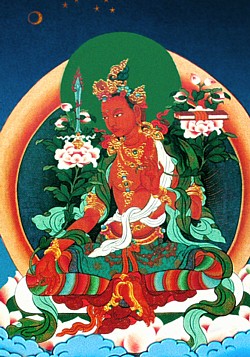Manjushri: Difference between revisions
Jump to navigation
Jump to search
mNo edit summary |
m (→External Links) |
||
| Line 24: | Line 24: | ||
==External Links== | ==External Links== | ||
* {{LH|topics/manjushri|Manjushri series on Lotsawa House}} | |||
* {{LH|tibetan-masters/sakya-masters/jamyang-khyentse-wangpo/manjushri-few-remarks|A Few Remarks—An Explanation of the Praise to Noble Mañjushri known as Glorious Wisdom’s Excellent Qualities}} | * {{LH|tibetan-masters/sakya-masters/jamyang-khyentse-wangpo/manjushri-few-remarks|A Few Remarks—An Explanation of the Praise to Noble Mañjushri known as Glorious Wisdom’s Excellent Qualities}} | ||
*[http://www.himalayanart.org/pages/manjushri/index.html Manjushri outline page at Himalayan Art Resources] | *[http://www.himalayanart.org/pages/manjushri/index.html Manjushri outline page at Himalayan Art Resources] | ||
Revision as of 08:20, 8 July 2012

Mañjushri (Skt. Mañjuśrī; Tib. འཇམ་དཔལ་དབྱངས་, Jampalyang; Wyl. 'jam dpal dbyang) or Mañjughosha (Skt. Mañjughoṣa; Tib. འཇམ་དབྱངས་, Jamyang; Wyl. ‘jam dbyangs; 'the Gentle Voiced') is
- one of the eight great bodhisattvas who were the closest disciples of the Buddha. In this form, he sometimes appears whitish-green in colour and holding a lily to symbolize renunciation of the destructive emotions.
- the embodiment of the knowledge and wisdom of all the buddhas, traditionally depicted with a sword in his right and a text in his left hand.
Jamyang Khyentse Wangpo says:
- In definitive terms, Mañjushri, you are now, and from the very beginning you have always been, a genuine buddha, in whom all the qualities of abandonment and realization are totally perfected, because you completely traversed all ten bhumis, such as the Joyous and so on, and purified the two obscurations, together with any latent habitual tendencies, many incalculable aeons ago. Nevertheless, from a merely provisional perspective, you appear as the foremost of all the bodhisattvas, and demonstrate the means of training as a bodhisattva in the presence of all the victorious ones and their heirs throughout the ten directions.
- Moreover, from the perspective of the mantrayana, there is no doubt whatsoever that you, Mañjushri, are a buddha. In fact, this is even stated in the sutras. In the Sutra of the Array of Mañjushri’s Pure Land, for example, it says you have completed the ten bhumis. And in two other sutras—the Shurangama-samadhi Sutra and the Angulimala Sutra—you are clearly referred to as a buddha. [1]
Notes
Teachings Given to the Rigpa Sangha
- Orgyen Tobgyal Rinpoche, Lerab Ling, 30 May 2011
Further Reading
- Jamgön Mipham, A Garland of Jewels, (trans. by Lama Yeshe Gyamtso), Woodstock: KTD Publications, 2008